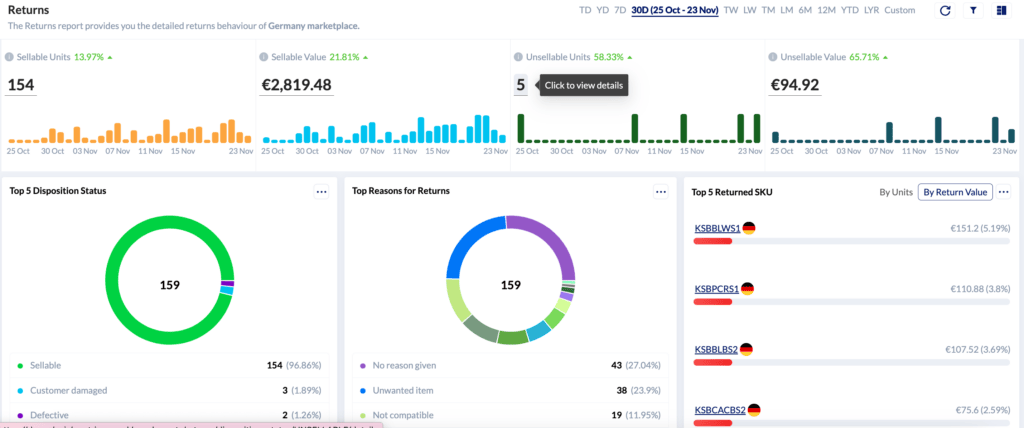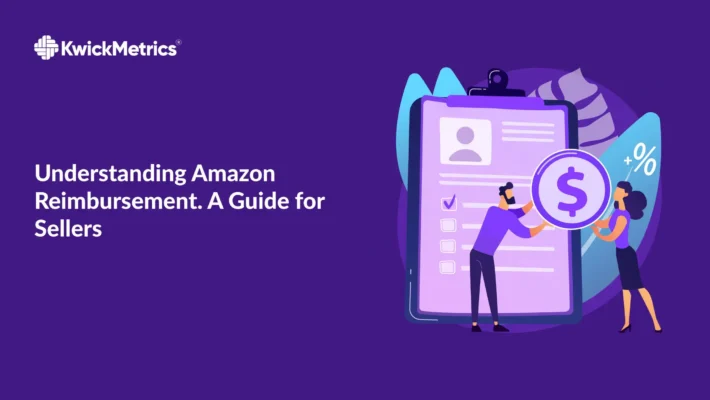Amazon Unfulfillable Inventory: A Seller Guide

Table of Contents
- Understanding Amazon Unfulfillable Inventory
- The Old Process of Handling Unfulfillable Inventory
- The Updated Process for Managing Unfulfillable Inventory 2023
- Try Our KwickMetrics - One Tool with Multiple Solutions!
- Benefits of the New Updated unfulfillable Process
- Identifying Unfulfillable Items During FBA Shipment Processing
- KwickMetrics - The Business Intelligence and Analytics Tool
- FAQs in Relation to Amazon Unfulfillable Inventory
- Conclusion
Have you ever felt the sting of an unexpected curveball? Picture this: You’re a diligent Amazon seller, checking your inventory management system when suddenly, there it is. A word that sends chills down any seller’s spine – amazon unfulfillable inventory. It’s like a nightmare come true – that moment when your foot makes contact with a tiny, painful Lego piece in the darkness.
Your once sellable products are now sitting in Amazon’s warehouse, gathering dust and accumulating storage fees. What if I said there was an alternate path? In our journey together through this post, we’ll pull back the curtain on how items get flagged as amazon unfulfillable inventory and even more importantly – how to manage them effectively. From understanding why products end up in ‘unfulfillable’ purgatory to learning about Amazon’s updated process for managing these troublesome goods.
Understanding Amazon Unfulfillable Inventory
If you’re an Amazon seller , navigating the waters of unfulfillable inventory can feel like a daunting task. But don’t worry, we’ve got your back.
What is Unfulfillable Inventory?
In simple terms, “unfulfillable inventory” refers to items in your Amazon FBA stock that are not in sellable condition. This could be due to various reasons such as defects in manufacturing or design, incorrect user instructions on the product packaging, damaged item received by customer return or even expired products.
The tricky part is when these items get mixed up with your fulfillable inventory and cause unnecessary storage fees at the fulfillment center. To avoid this financial sinkhole and maintain a healthy bottom line for your business, it’s essential to identify and manage unfulfillable inventory effectively.
Reasons for Items Becoming Unfulfillable
Digging deeper into why certain items become unsellable provides us more clarity on managing them efficiently. An item may fall under ‘inventory unfulfillable’ category if they have any sort of labeling defect or wrong warning labels which doesn’t comply with Amazon’s strict guidelines – remember those pesky long-term storage fees? Yeah. Non-compliance can lead there.
Besides labelling issues, returned products often contribute significantly towards increasing the pile of un-shippable too. Customers might return purchased goods because they were either damaged during transit (warehouse damaged), had distributor damage from prior handling stages before reaching amazon’s network or perhaps carried manufacturing defects right off-the-bat from production stage itself; all leading towards growing mountain of ‘unsellable’ – making life tougher for our dear sellers out here.
Statistically speaking, as per a report, approximately 1 in every 5 items become unfulfillable due to customer damaged reasons and another 3 out of those are returned because of manufacturing defects. As an Amazon seller, these numbers should be concerning enough to have you prioritize inventory management.
But the challenge doesn’t stop here. We’re talking about products with expiration dates, like groceries. It’s a whole different ball game.
Key Takeaway:
Mastering Amazon's unfulfillable inventory is crucial for FBA sellers. These are items not in sellable condition due to defects, incorrect instructions, damage from returns or expiration. They can rack up storage fees if mixed with fulfillable stock. Reasons they become unsellable include labeling issues and damages during transit or manufacturing.
The Old Process of Handling Unfulfillable Inventory
Amazon’s earlier method for managing unfulfillable inventory was straightforward but lacked flexibility. Sellers had to manually sift through their Seller Central account, pinpointing items that fell into the dreaded ‘unfulfillable’ category.
This process involved creating a removal order to take out the flagged items from Amazon’s fulfillment centers. While this approach let sellers remove inventory, it often proved time-consuming and somewhat burdensome, especially when dealing with large volumes of products.
The Updated Process for Managing Unfulfillable Inventory 2023
Amazon’s fresh take on managing unfulfillable inventory is a breath of fresh air for Amazon sellers. The new system, implemented in 2023, brings a slew of innovative options to the table.
Refurbishment: Transforming Damaged Goods into Marketable Assets
Consider the possibility of refurbishing damaged items, breathing new life into products that were once deemed unsellable. This process not only minimizes waste but also has the potential to recover lost revenue from items that may have otherwise been discarded.
FBA Refurbishment Services: Amazon’s Solution for Salvageable Items
Take advantage of Amazon’s FBA refurbishment services, designed to address items with damaged packaging but are otherwise sellable. This automated service includes repackaging, which is automatic for eligible items, and optional refurbishment. With FBA, you can choose to opt in or out of refurbishment services, allowing for flexibility in managing your inventory. Refurbishment can involve actions such as re-taping, re-gluing, re-stapling boxes, removing excessive tape, labels, and stickers, and even steaming and stain removal for shoes and apparel.
Grade and Resell: Unlocking New Opportunities for Unfulfillable Inventory
Assess the condition of your inventory and categorize items based on their state. Consider reselling products that are in acceptable condition, maximizing your returns on items that can still meet quality standards.
Liquidation: When All Else Fails, Sell in Bulk at Lower Prices
If refurbishing proves unviable or cost-ineffective, explore the option of liquidation. This involves selling unfixable goods in bulk at discounted rates, providing an alternative to discarding them entirely. While it may not yield top dollar, it allows you to recoup some value from items that might otherwise go to waste.
Dispose Responsibly: Donate Unusable Items to Those in Need
For items that can no longer be used or sold, responsible disposal is essential. Opt for disposal methods, but consider going a step further by donating damaged or unsellable items to charities through the FBA Donations program. While usual disposal fees apply, this program allows you to contribute to charitable causes and reduce environmental impact.
By incorporating these strategies, you not only minimize waste but also explore avenues for recovering value from products that might otherwise be considered unsalvageable.
Try Our KwickMetrics - One Tool with Multiple Solutions!
Key Takeaway:
Amazon's innovative approach to unfulfillable inventory presents a unique opportunity for sellers dealing with damaged goods. Now, you have the option to refurbish items and give them another shot at being sold, which significantly reduces waste. If that doesn't work out, think about liquidating unsellable items in bulk - it's a way better alternative than just tossing them away. And remember, tools like KwickMetrics are your best friends when it comes to managing your inventory.
Benefits of the New Updated unfulfillable Process
The revamped process for handling Amazon’s unfulfillable inventory offers a myriad of advantages, primarily enhancing seller flexibility and customer experience. This is an area where potential revenue has been sitting untapped, so let’s get into why this change is such a game changer.
Seller Account Flexibility: The new system gives sellers more control over their unsellable items. It allows them to decide whether they want to have these products returned, disposed of or even liquidated – opening up opportunities for recouping some costs that were previously deemed lost.
Potential Revenue Recovery: Instead of just writing off unfulfillable stock as a loss, you now have the option to potentially recover some value from it. For instance, through Amazon’s Liquidations program, you can choose to sell your unfulfillable inventory in bulk lots on secondary markets—this could turn previous losses into newfound profits.
A Reduced Waste Footprint
Beyond just boosting bottom lines though, there are broader environmental benefits too. Previously discarded goods can now find second lives rather than ending up in landfills—a huge win when considering the importance of reducing waste in today’s climate-conscious society.
This step not only enhances your business practices but also helps build goodwill with customers who increasingly prefer businesses mindful about their environmental footprint.
An Improved Customer Experience
Innovative processes like refurbishing make sure buyers receive products in good condition despite being initially flagged as ‘unfulfillable’. By focusing on improved product quality control measures within fulfillment centers and streamlining return processes, Amazon is ensuring that customers continue to receive the high standard of service they are accustomed to.
With Amazon’s FBA Customer Returns Policy, when a customer return is processed, Amazon can determine if it’s in sellable condition. If not, you have options. You could choose for Amazon to evaluate and possibly refurbish the product before it gets back on your virtual shelves. This ensures a better shopping experience for future buyers—happy customers mean repeat business.
The Power of Data with KwickMetrics
At KwickMetrics, we give sellers priceless insights into their data. This lets them make more informed decisions about their business strategies. Through our platform, sellers gain a comprehensive understanding of their performance metrics, sales analytics, return reports, profit and loss. This depth of insight is a priceless asset, enabling sellers to adapt and optimize their strategies for greater success on the Amazon marketplace. At KwickMetrics, we believe that the true power of data lies in its ability to guide strategic decisions and elevate the overall performance of every seller.
Key Takeaway:
The updated process for Amazon's unfulfillable inventory not only boosts seller flexibility and potential revenue recovery, but also improves customer experience and reduces environmental waste. Sellers can now choose to return, dispose of or liquidate unsellable items—turning previous losses into possible profits. Plus, by offering refurbished products and using data insights from tools like KwickMetrics, sellers have a great opportunity to optimize their sales strategies.
Identifying Unfulfillable Items During FBA Shipment Processing
Navigating the world of Amazon FBA can sometimes feel like walking through a maze, especially when it comes to identifying unfulfillable items during shipment processing. This task is essential for ensuring your inventory doesn’t get flagged as unfulfillable and end up in the dreaded “unfulfillable column”.
The process starts with an understanding of what makes an item marked as unfulfillable. It could be due to damage that occurred at the fulfillment center or during transit by a partner carrier, customer damaged returns, distributor damaged goods, or even manufacturing defects.
Damaged Packaging: The Common Culprit
A common reason why items are deemed unsellable lies in their packaging. Damaged packaging might seem insignificant but think about this – would you buy something off the shelf if its package was torn or crushed? Probably not. And neither will Amazon customers.
To avoid such pitfalls make sure all products have correct quantity details and user instructions labeled correctly. Warning labels should be visible too; otherwise, they risk being classified under ‘incorrect user’ category leading them straight into the ‘items returned’ section.
Quality Checks: An Ounce Of Prevention Is Worth A Pound Of Cure
Prior to shipping any product out for storage at an Amazon fulfillment center ensure that each item is in sellable condition and free from any warehouse-damaged marks. A good way to manage this step effectively is by conducting regular audits on your stock before sending it over to Amazon’s vast fulfillment network.
The Power of KwickMetrics Tool
Are manual checks feeling like a tedious task? Enter the KwickMetrics tool, a game-changer for Amazon sellers. Beyond providing solutions like sales and advertisement analytics, it takes the lead in managing unfulfillable inventory by offering insights into the reasons behind flagged items.
Dive into returned products effortlessly with KwickMetrics. Whether it’s damaged goods or expired grocery items, this tool spotlights issues, making it easy to identify and address problems swiftly, ensuring efficient operations.
KwickMetrics effortlessly tackles the task of managing unfulfillable inventory on Amazon by providing comprehensive insights into return reports, sellable items, and unsellable data.
Gain a bird’s-eye view of your Amazon seller account with KwickMetrics. Track items marked as unfulfillable due to reasons like warehouse damage or customer returns. But it doesn’t stop there—the tool goes further, helping manage these products efficiently, minimizing loss for business owners.
Key Takeaway:
KwickMetrics allows you to keep a close eye on your inventory, ensuring nothing slips through the cracks. By regularly monitoring your stock's condition and quickly addressing any problems that arise, you can maintain high-quality offerings for Amazon customers and minimize unsellable items.
Detailed analytics are at your fingertips with KwickMetrics. In this competitive marketplace, every piece of data counts. Understand why items are flagged as unfulfillable, whether it’s manufacturing defects or poor packaging conditions, and take appropriate measures accordingly.
KwickMetrics - The Business Intelligence and Analytics Tool
Explore 14-day free trial! No credit card required, cancel at any time.
Navigate Amazon’s complex fulfillment network with ease. KwickMetrics provides insights into storage fees and long-term storage costs, empowering you to make informed decisions about handling your stock levels better.
Dealing with customer returns just got easier. KwickMetrics offers seamless solutions to handle return requests effectively, lightening the load for online store owners.
Key Takeaway:
Mastering Amazon's unfulfillable inventory is no longer a daunting task with KwickMetrics. It gives you an eagle-eye view of your account, smart management for flagged items, and deep sales insights to improve decision-making.
FAQs in Relation to Amazon Unfulfillable Inventory
What does unfulfillable inventory mean on Amazon?
Unfulfillable inventory refers to items stored in an Amazon warehouse that can’t be sent out due to issues like damage, defects or expiration.
How do I remove unsellable inventory from Amazon?
To get rid of unsellable stock, you need to submit a removal order through your Seller Central account. This tells Amazon what and where to send the stuff.
What does Amazon do with unsellable items?
If they’re not removed by sellers, unwanted goods are either donated via FBA Donations program or trashed following certain guidelines for waste disposal.
Can I sue Amazon for losing my inventory?
Suing isn’t the first step but if you’ve lost products at their fulfillment center, contact them about reimbursement. Legal action is usually last resort when negotiations fail.
Conclusion
Mastering the realm of Amazon unfulfillable inventory is no easy feat, but you’ve taken a major stride forward. You now understand what makes an item unfulfillable and why it’s crucial to manage these products proactively.
We delved into how Amazon has evolved its approach over time – making strides in reducing waste and improving both seller flexibility and customer experience. And let’s not forget about identifying those troublesome items during FBA shipment processing!
The journey doesn’t stop here though. There are tools like KwickMetrics that can provide insights to help manage your returns even more effectively.
You’re well on your way towards transforming dreaded unfulfillable items from costly storage fees into potential revenue generators for your business! Keep pushing forward!



